Rina: I grew up in Blacktown, where my parents settled after coming from Holland. My father was a very keen vegetable grower because he wanted to grow enough for the family, and we had a big family. So my gardening skills came from him. It was mainly vegetables, he wasn’t that interested in flowers, only to make the garden at the front look a little bit better, but the backyard was for the vegetables, for eating.
We had everything: beans, potatoes, carrots, radishes, strawberries, and spinach. We put the scraps from the kitchen back into the soil. We didn’t have compost bins in those days; it was just a matter of digging a hole and covering it with soil and then the next few months growing something over the top of it.
Gordon: I grew up only about a mile from here in Five Dock, and the soil was not too different from Haberfield. The backyard was probably smaller than the one we have now, but my father, like everybody back in the ‘50s, had a vegetable garden and he grew greens. He was very keen on peas and beans, which I remember because he ran a lattice work up so you could grow the plants up instead of being flat on the ground. I was never involved in that very much. You’d lend a hand, so it’s not entirely foreign, but I didn’t do very much gardening in my younger days.
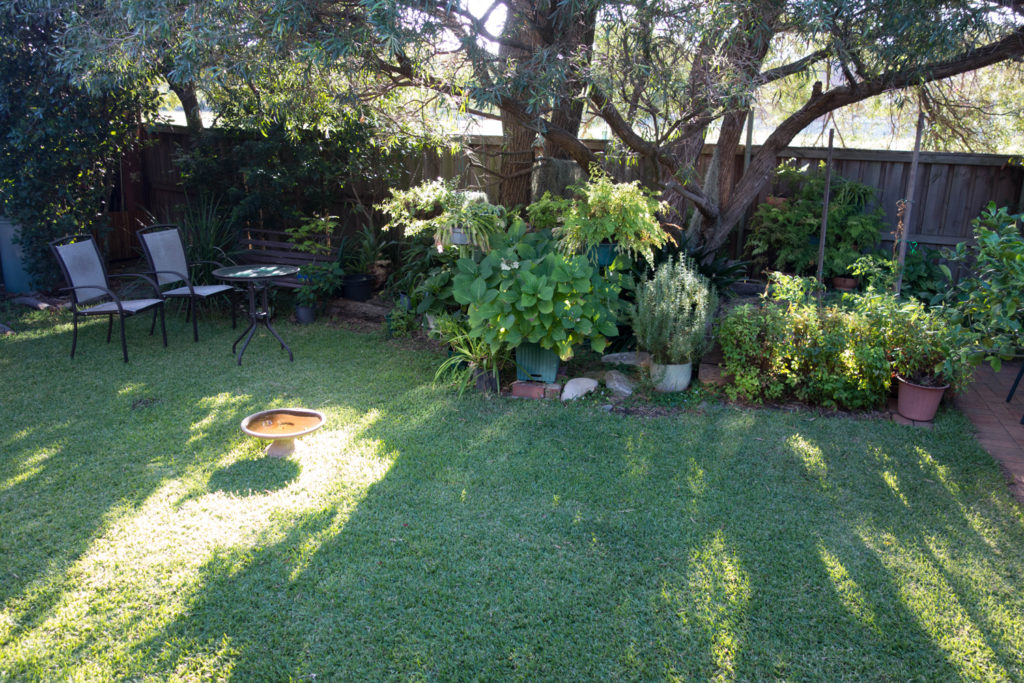
Rina: We have been here thirty years now, since November, 1986. There were pencil pines all the way across the back. So we got rid of those, so we could plant natives.
Gordon: And in that corner were several huge cactus plants. They were the first to go, especially as we had two young kids.
Rina: There was a shed where the chairs and tables are now. We didn’t really need it, and there was cement all the way up across the yard, so we put grass in up to where the washing line is. We’ve extended the house a metre, so we’d have taken some of the backyard for that. Put a little bit of paving there with pot plants on.
Gordon: And we insisted on having as much glass as we could, to see the garden, even though it’s on the western side. We have trees, so there is some sort of shade. In fact they’re growing a bit too big now.
Rina: The growth has been slow, over the years.
Gordon: We like a bit of lawn and just plants and greenery. Mostly this has happened without planning things. It has just occurred. Years ago we actually got a landscape gardener to draw us up a plan, a design for the garden, which probably was all right, but we’ve put that aside for a while, never got around to it. I think the way we’ve got it now is probably better, it’s just happened – he had it very planned, with semicircles here and there.
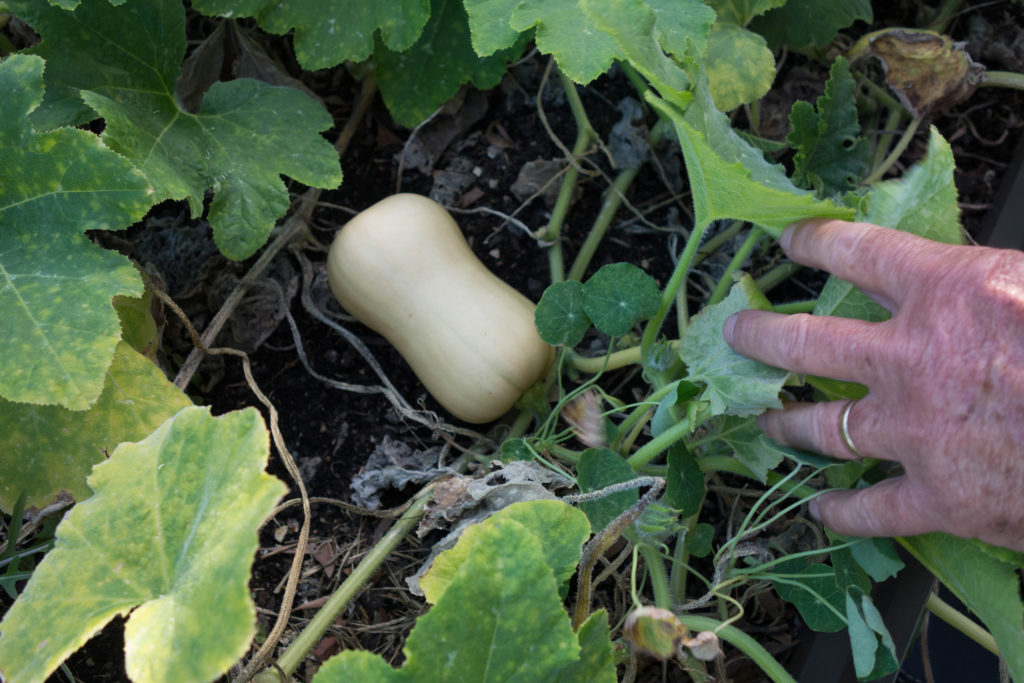
Rina: It was a bit too formal for us. Now it’s a bit of a mixture, some flowers and there’s a tiny little raised vegetable bed. Unfortunately because the trees have grown so big there’s too much shade now. I can’t really grow much there anymore, so that’s why we created a small veggie garden out the front, which has been overtaken by pumpkin. Something was growing in the back, and I realised the leaves were looking like pumpkin leaves, so I just left it in a small pot and then I put it outside. I’ve built another little bed, which has got tomatoes in it. I would have liked a larger property. I like the lemon tree in a pot. That gives us lots of good fruit.
Another function of this garden is that there’s a chance homes might be built in the property behind us, so we wanted to provide a bit of a shield as well.
Gordon: We had buffalo grass for the lawn, like everybody did in the 1950s and 60s, but we had kids running around, and then a dog, and of course we never tended it and it got a bit thin and weedy and patchy. Then when the builders worked on the extension and stored stuff on the lawn and dug up the pipes, and nearly all the grass was killed off. But after it was all finished we just kept watering and it all came back again. Rina is very careful about picking out weeds, she’s much better than me.
Rina: It’s the clover that gets me.
Gordon: There are two trees there, a melaleuca and a callistemon. They’re a bit hard to tell apart because they’ve grown up together, they’ve grown into each other.
Rina: We did have a beautiful tree behind us, it was a river gum and we used to get the galahs coming in and magpies and all the bigger birds as well. But unfortunately because of what was done there in the past, there was a lot of pollution and they had to dig up the tree and get rid of it because the pollution was all around the roots of the tree apparently.
Gordon: Well, they replaced the top level of the soil and they said that would damage the tree too much. We didn’t believe them for a moment… and the land still has problems with drainage.
Rina: The garden is a place to look at, if we are sitting inside, or we’re sitting out there enjoying it. It’s a double purpose.
Gordon: It’s almost like part of the house really, isn’t it? It’s like an outdoor room I often have breakfast out there if it’s warm and sunny enough.
Rina: Or morning and afternoon tea we sit out there, we’ve had lots of dinners outside. We love to watch the birds coming in. We have a birdbath out there and the magpies and the native miners and rosellas come in and have a bath, so it’s lovely to see. We love to potter around and put some more plantings into the pots and move them around and do various things with them. We have a son and daughter and when they come around or when we have our family gatherings we sit outside. I have a lot of brothers and sisters, so a lot of nieces and nephews, and we often have birthday parties, so we might in the summer have most of it outside in the garden.
Gordon: The birds come and perch in the trees. Over the years certain birds have made their nests. They use the bird bath like a landing strip on hot days, and sometimes there’s a bit of squabble over a place on it.
As Rina says, the native miners are probably the most common, but we’ve got a pair of magpies, we recognise these same two that come all the time. When lorikeets are around they’ll come, they feed off the grevillea. We sometimes see doves, and crested pigeons.
Rina: We had a pair of crested pigeons breed in our bigger tree at one stage, and we had two lovely little ones jumping on the table. It’s cute, we still see them, but they’ve never bred in there again.
Gordon: We don’t feed the birds, we just put out some water for them.
Rina: We’ve seen Willy Wagtails come and sit here as well. And small blue wrens in the evening.
Gordon: Honey eaters occasionally.
Rina: Yes, we’ve had a New Holland Honey Eater.
Gordon: So it doesn’t take much to attract birds, just make it safe for them and provide some water. The other morning there would have been hundreds of cockatoos came across here, all screeching away, it was deafening. We get some bats across the road in the Moreton Bay fig trees. They’re fine, they don’t worry us. But the koels are so noisy early in the morning.
Rina: We used to have a dog, so I think we see more birds now that we don’t have a dog or a cat.
Gordon: We sometimes plant things we see around Haberfield. We planted a Murraya and then a native frangipani. It’s never done really well but it’s held on. The flowers are beautiful when they come out. We chose it because it doesn’t spread, it basically stays compact and we knew it wouldn’t grow over the fence so that’s what we wanted. I think if it was by itself, instead of being overpowered by other trees left and right, it would have been much better. The flowers are almost like orange blossom, very nice.
Rina: If we see something nice when we’re out shopping, we might buy a plant, but we don’t have any specific plans for the future of the garden.
Gordon: All the ones underneath the trees, they’re all in pots, some are hanging, some are standing on the ground. Well, we never planned that but it’s turned out all right. Rina cracks the whip about making sure they get watered every evening and most of them we’ve just said ‘Oh, where do we put this? We’ll put it here for the moment until we decide.’ Well, it stays there. Some of those plants we inherited from my folks, they had them in their garden, a few of those hanging ones.
Dad was very big on hanging pots and baskets and he had a shade house that he built himself many years ago. When they died and we sold the house we brought some of the pots back here with us. You can see the ones that are hanging off the branches of the trees and the ferns over against the fence, they’re on a shelving system on three levels. They all came from Five Dock.
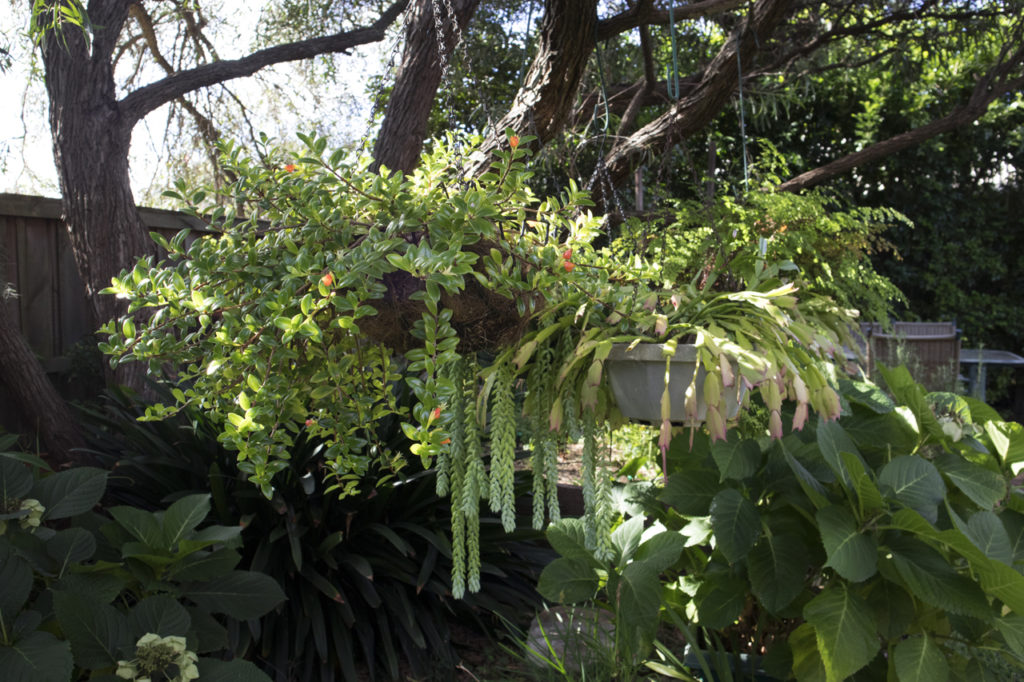
Rina: Yes, and they do seem to like it there anyway, it’s shady.
Gordon: We even brought some of our pots and things that my father made, probably from leftover concrete when he was helping to rebuild the house in the 1940s. We’ve still got one of those, haven’t we?
Rina: I hope not [laughs]. I’ve been throwing them out behind Gordon’s back!
Gordon: I was onto you. But there’s one around there, I think the one that the azalea is in, the round pot. No, that was a bought one: that was too good to be Dad’s.
Rina: No, you could be right, the azalea one could be his.
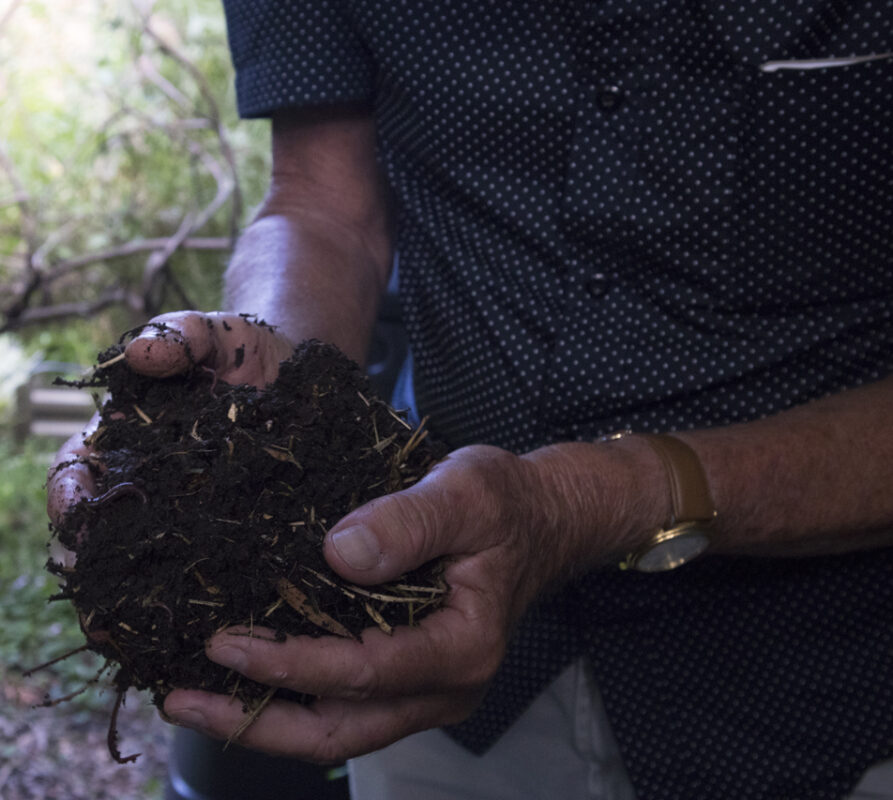
Rina: Our gardening has changed since I work less and as Gordon has retired, so we probably do a bit more gardening than we did in the past. We do sometimes garden together, or sometimes if I’m at work Gordon might garden himself, or if Gordon is doing something else I might garden on my own, so it just varies depending on what time we have.
Gordon: I’ve become a real enthusiast about compost and worms. I’ve got two barrels going and we throw in all our green waste, food waste and paper and grass clippings and keep tending it so that it doesn’t get too wet or too dry I leave it for a couple of months and it’s wonderful compost.
Rina: Well, you bought a worm farm initially, tending the worms for years.
Gordon: They were the ones where you have trays. That worked quite well for a while and then it seemed we got out of step with it. It kept going but it wasn’t as effective as I thought.
Rina: It took a long time to produce any good quality compost that we could use for the garden, so then Gordon moved onto those barrels.
Gordon: I’ll introduce you to some of the worms. The barrels open at the bottom. Occasionally we found a rat would start digging underneath, so we bought some paving slabs and put four down and the round bins sit there. We left a gap of about a centimeter in between so water can drain out, and that seems to work quite well, no sign of rats for a year or two now. And I got one of those corkscrew stirring gadgets – it’s steel and it’s got a handle on top so you just wind it and the thing goes down and then you pull it up and it moves the compost around. I do that every day.
Gordon: We have a small bin to keep in the kitchen and we empty it out every day, otherwise it gets smelly. So that’s a reminder.
Rina: So not only does Gordon supply the compost, he takes all the worms out, he sits patiently and plucks all the worms out and puts them into the new bin so that we don’t kill them.
Gordon: Those ones apparently don’t survive in the wild in the garden, because in hot weather it dries out and they die. There’s one thing that I don’t like as well, I’ve learnt it’s the maggots of black flies, but haven’t had them for a year or two now, fingers crossed. But when they come in, they’re these little worms and they’re in segments and they’re oozy and they grow in the thousands, and they’re all slimy as well. People say that they’re good, all they do is just chomp up the stuff and once they get a bit bigger some people use them for fishing bait.
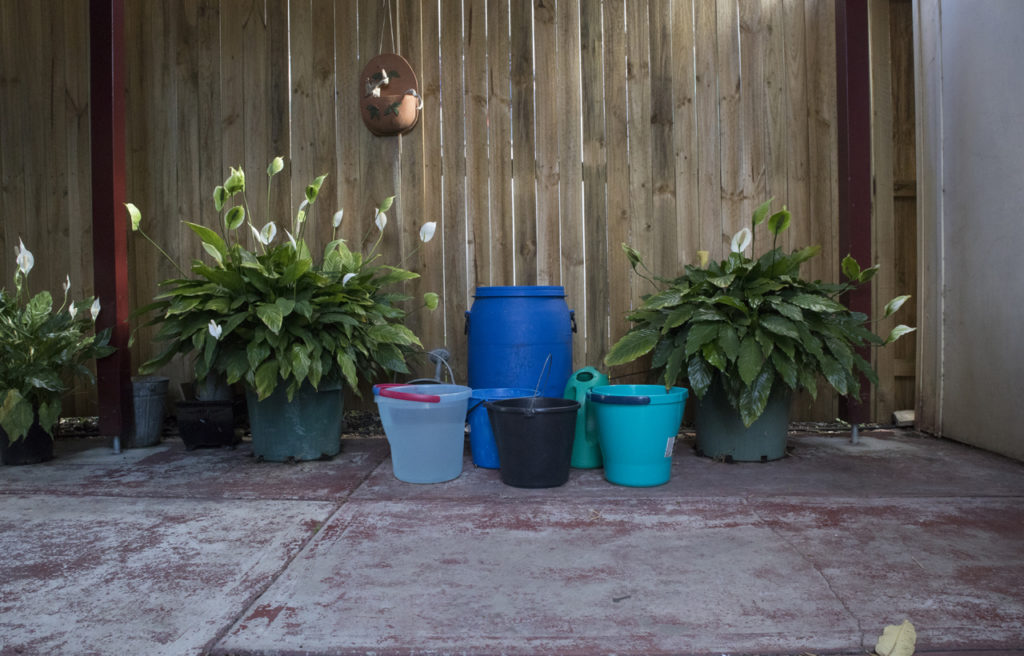
And this is our water collection system. When we had this shed built a few years back we were planning on putting a water tank in, but we couldn’t decide how to do it. I hate having a big plastic thing in full view, and I still can’t see how to do it to my satisfaction. So the builder said, ‘We’ll put this drainpipe in here and when you decide what to do I’ll fit the other end of the pipe.’ Well, it’s been years of course. So we’ve kept water in a big plastic bin for the time being and once it gets a bit filled we fill up that extra barrel there. It rained the other day of course so we fill up a few buckets to use the water.
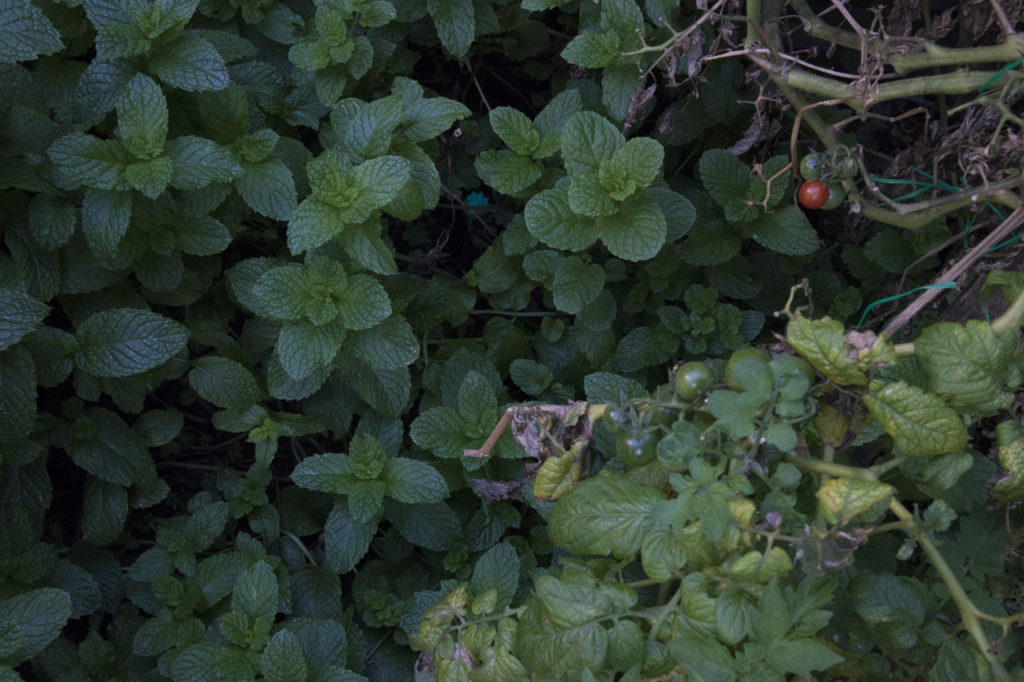
Rina: I’m hopeless at remembering plant names. There is a plant in the veggie patch that came from a person that I work with and she says it’s very good for you. But I don’t know what it is, and she couldn’t tell me in English, she is from Portugal. They’re like little black seeds if I remember rightly. I grew it a few years ago and I hadn’t seen it and then suddenly this year it’s come through again. And tomatoes, you can’t stop them. And there’s a herb as well I forget the name of, and it’s supposed to be very good for your brain, it’s very bitter. I did have the label there but I think I’ve lost it now. And I’ve planted this silverbeet here recently. I’m hoping they’ll still get enough sun to grow. There’s thyme and Vietnamese mint.
Gordon: And mulberries. We know of a couple of feral mulberry trees around here. These are offspring. About two years ago Rina noticed on the ground underneath, all these little plants. She put two and two together, so she dug them up and brought them home.
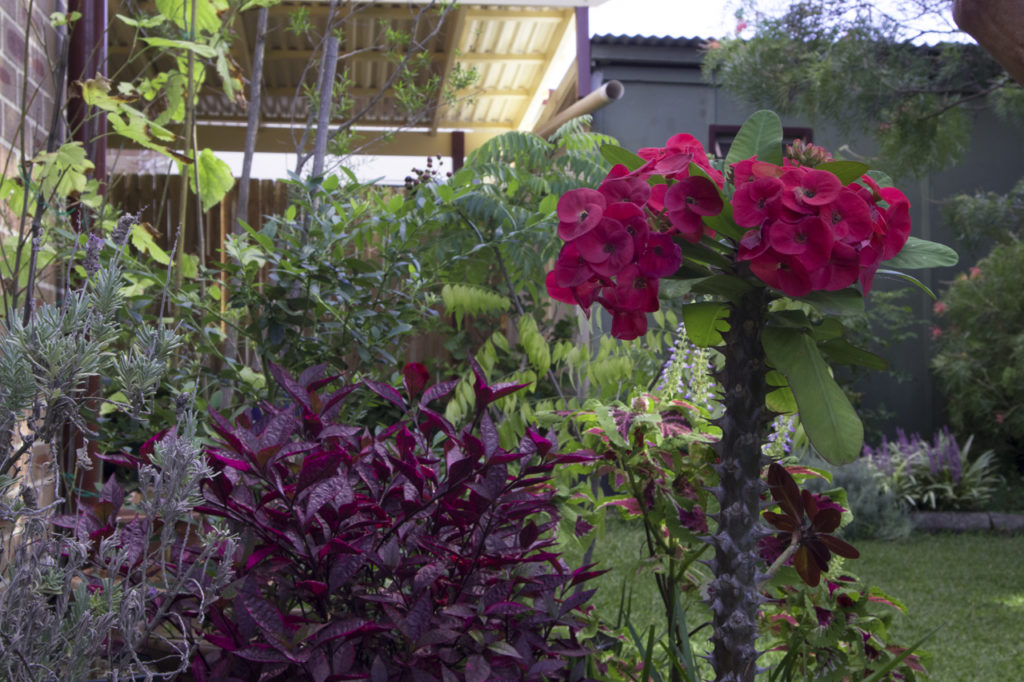
Gordon: We love the bright red Euphorbia, which was given to us by the neighbours two doors up. It was only very small and we kept it on our front veranda and it started to grow a bit bigger. We don’t want it to get any bigger than this, it’s going to take over the house. So what we’re wondering is, if you cut off the top, does it regrow from where you cut it?
Rina: When the neighbour gave it to us she said if you want to create more you have to cut the little side branches off and just pop that in the pot.
Gordon: We knew nothing about those until she gave it to us, and now of course you spot them around, and “Ah, we know what that is.” And we have plants in pots that were growing in the cracks between the bricks on the paving when I tidied up. I have planted offspring of our trees along the canal where there’s space, and I gave one to a workmate of mine. He went up to Taree and he grew several. Another friend of ours planted one on her driveway, a steep little driveway, we were up there just recently and she said: “There is the tree!” That was 25 years later. It’s a huge tree.
I also like cuttings. I was in Hyde Park, they had large flower beds with coleus in a whole array of colours, even dark purple ones, in geometric, concentric beds. I must go back and get a few clippings. So, if it’s a soft plant I’ll stick it in a bottle or something and leave it on the windowsill and hope it’s going to grow some roots.
Gordon: Haberfield is full of great gardens. There’s a fellow in Waratah Street, probably about my age. He’s Portuguese and his front garden is full of flowers and shrubs and trees, and in the back garden he’s got whole large areas and he’s keen veggie grower, and fruit and flowers. And a neighbor a few doors down from us is a very keen gardener. I. She’s got so many bits and pieces hanging off all the fences so the garden virtually grows up the fence. She won best garden one year. On our street there’s a house rented by students. They’ve done amazing things growing plants in pots and various other vessels. They cut the centre out of an old table, it sits outdoors and they put a metal tray in there and grew a garden in the middle of the table.
People often say Haberfield is the garden suburb, so I think a lot of people get the idea that we all have really grand gardens, but we don’t. All we are is just a regular suburban spot. The whole point was that when Richard Stanton did the development in about 1901, he laid down that each house had to have a garden, as opposed to all the small terrace houses in nearby Glebe and Leichhardt.
We often walk in either Kingston Street or O’Connor Street, just either side of Deakin Avenue, and I think they’re rather nice. Largely because they usually have a bit of lawn in the middle, but the owners have done things around the outside.
One house in Kingston Street with a wide area on the side has a maze, a complete maze, all in hedging.
Rina: When we have the garden competition I’m certainly inspired, they’re wonderful usually. Gordon shows me the photos and that inspires me.
Gordon: I wasn’t there when the very start of the garden competition but apparently there was one in the 1970s or ’80s, with an earlier generation of people, but that sort of faded away. Then it was about the late ’90s when Jeff Malyon and a few others revived it. Everybody who takes part all love looking at everybody else’s gardens, and we’ve met so many people. It’s not a very big suburb, so the same sort of people often enter each year, but you always get new ones and it surprises us – all sorts of people and gardens.
One problem with the competition is arranging categories that cover as many people as possible without being too specific. Several times people have suggested we should have historic gardens, like Federation style gardens, but we soon realised that really there are no real Federation gardens. There are ones that have some features or some aspects of it, some of them come close, but it’s too small a category. Well, at the moment the categories are large and small gardens front or back, and then whole garden for the grander ones. There’s always a few categories like veggie plots and potted and containers, because a lot of people don’t have room for an “in-the-ground” garden. We’ve had a few one-off light-hearted categories over the years to keep things interesting. One I have in my mind is hedges; you know, people can do great things with hedges. One year we had letterboxes. We even got the local postman involved in that, and he was very keen. But people didn’t enter for that, we actually recruited entries. We called it the Postman’s Pick.
Rina: I’m interested in setting up a community garden. There’s an area called the “Secret playground” around here. You hardly ever see anyone in there now, so we’re thinking of asking if the council will allow us to put a community garden in there at some stage. It would need a lot of effort to get it going, but quite a few of our friends are interested as well.
Gordon: It will happen. What sort of life is it that you don’t have any time just to potter around? You don’t have to have things that need loads of work all the time; it’s okay if you want to, but you don’t have to do that.
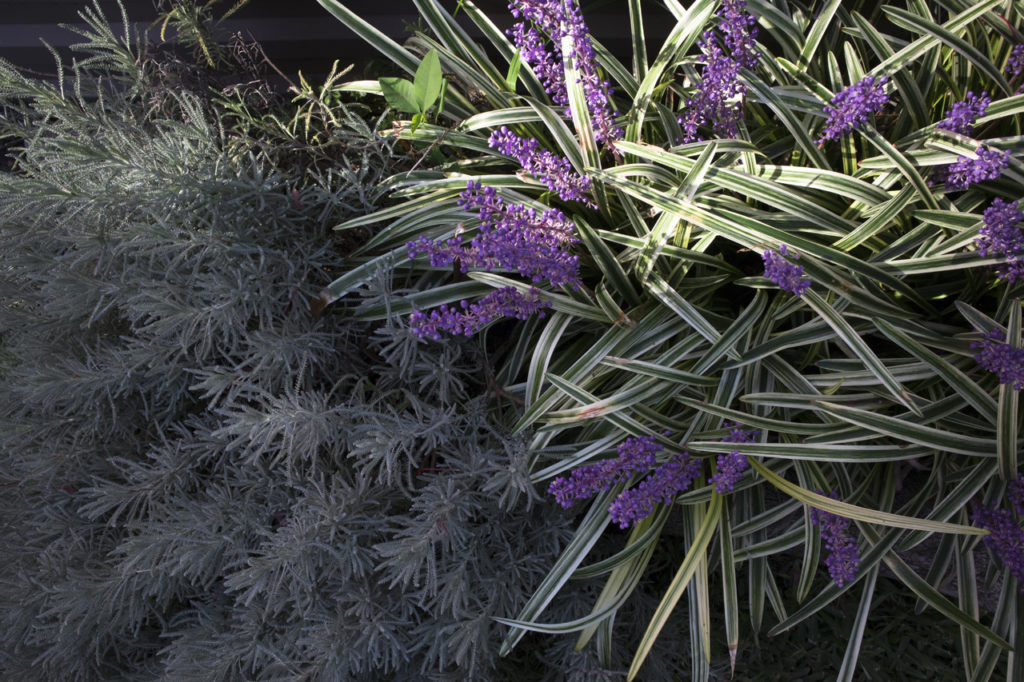

0 Comments